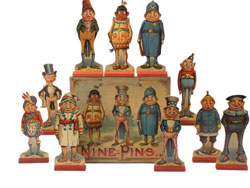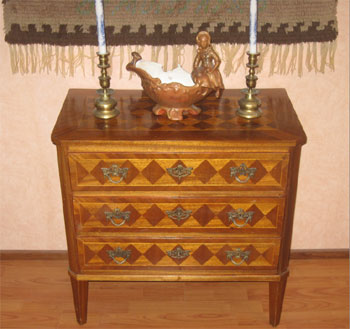Early American toys, trains and firefighting vehicles raced past their estimates at Noel Barrett’s May 21 ‘Something for Everyone’ auction
August 28th, 2012 by admin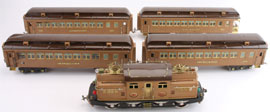
Lionel 408E standard gauge train set with electric engine, four compartmented coaches and original boxes, sold via the Internet for $35,395.82. Noel Barrett Auctions image.
NEW HOPE, Pa. – Prior to Noel Barrett’s richly varied May 21, 2011 “Something for Everyone” sale, some collectors speculated that the whimsical clockwork veggie man on the catalog cover might take the blue ribbon on auction day. While the cheeky, 16-inch papier-mache Halloween figure did surpass expectations to sell for $16,520 (all prices inclusive of 18% buyer’s premium); it was a modestly estimated Lionel train set that took the express journey to the top of prices realized.
The Lionel 408E standard gauge set with electric engine and twin Bild-A-Loco motors pulled four compartmented coaches identified as 412 California, 413 Colorado, 414 Illinois and 416 New York, the latter being an observation car. All of the cars – which were finished in tan and chocolate brown with cream window frames and peacock-blue accents – came with their original boxes. The set drew numerous competitors, with an Internet participant claiming the lot for $35,395.82. The bidder eventually drove six hours to Pennsylvania to collect his prize.
“It was an exquisitely rare train set in that particular color scheme. The selling price was a very nice surprise for the consignor and proved yet again that, in today’s marketplace for antique and vintage trains, it’s the collectors who call the shots,” said auction company owner Noel Barrett.
Trains proved to be the sale’s strongest suit. An American-profile Carette gauge 1 #2350 steam loco and tender featured in Paul Schiphorst’s book The Golden Years of Toy Trains had been entered in the sale with a $12,000-$15,000 range. But with energy to burn, it powered its way to a $29,500 finish.
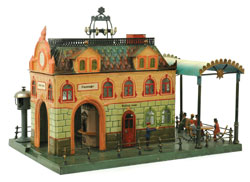
Marklin Central-Bahnhof train station #2651, hand painted with candlelit interior and furnishings, $23,600. Noel Barrett Auctions image.
Superbly hand painted and designed for illumination by candlelight, a Marklin Central-Bahnhof train station #2651 was outfitted with a table, chairs and benches. Its sumptuous details included etched and stained glass windows, doorway arches, a canopy and ticket-queue rail. Perhaps the best preserved of all known examples, the perennially popular German train station achieved $23,600 against an estimate of $10,000-$15,000.
Toys with a firefighting theme “never suffer a shortage of interest,” Barrett remarked. A case in point was the salesman’s sample fire ladder wagon made by Seagrave Co., the oldest continuous manufacturer of fire apparatus in America – and still in existence. The 50-inch-long sample fire wagon from the 1890s included an array of ladders, fire axes, extinguishers, lanterns and fire buckets. It settled just short of its high estimate at $10,030.
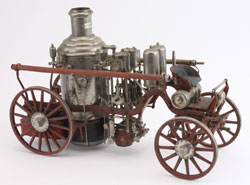
Fire pumper model, spirit fired and believed fully functional, 21 inches long, weight 32 lbs., $8,260. Noel Barrett Auctions image.
A mechanical marvel replicating a spirit-powered fire pumper was described in Barrett’s catalog as “one of the most amazing…we have seen.” Fully functional, it included double-pump pistons, valves and a flywheel crafted from brass and iron, with nickel-plated wheel rims and other components. Estimated at $6,000-$7,000, it blazed to $8,260.
Early automotive advertising showed its muscle in the form of a self-framed Marathon Tires sign depicting two anxious couples in a red open tourer, navigating a narrow, craggy ledge. Retaining an original paper label on verso from the famed tin sign maker Kaufmann & Strauss, the 22¾ inches by 19¾-inch advertisement applied the brakes within estimate at $16,520.

George Brown painted-tin horse-drawn omnibus stenciled “Broadway & Central Park,” $12,980. Noel Barrett Auctions image.
Several highly desirable American painted-tin toys were offered in the May 21 auction. Two of the best were attic finds. Discovered in California, a Fallows 1886 (patented) Buffalo Hunter, whose design includes a pair of rocking buffalo on a wheeled base, surpassed its $2,000-$3,000 estimate to realize $7,670. A George Brown horse-drawn omnibus stenciled “Broadway & Central Park” was a fresh find from a Long Island home. It had a smooth ride all the way to its above-estimate $12,980 destination.
A third 19th-century American toy highlight in the sale was the Hull & Stafford “America” clockwork locomotive that came directly from the collection of Disney animator and train collector extraordinaire Ward Kimball (1914-2002). Made of stenciled tin and wood with cast-iron wheels, it was one of only two toy trains retained by Betty Kimball (1912-2010) when her husband’s incomparable collection was consigned to Barrett’s in 2004 and 2005. “The Hull & Stafford ‘America’ was always one of Betty’s favorites,” Barrett noted. Estimated at $3,000-$4,000, the charming, primitively styled red and yellow locomotive was a crowd favorite. It ended its bidding run at $11,800.
Other standouts included a set of McLoughlin paper litho on wood Brownie ninepins $7,670 (est. 2,000-$3,000) and an Erzgebirge painted-wood village consisting of 12 structures and numerous accessories, all housed in a bentwood box, $5,310 (est. $700-$1,000). An antique Parisian perfumery came to the auction podium stocked with a multitude of miniatures that included various fragrances in glass bottles, powders, soaps and pomades arranged on mirror-topped counters and on vanity shelves. The deluxe emporium was also accompanied by a shop attendant: a well-dressed, bisque-head doll outfitted in fashionable turn of the 20th century attire. Estimated at $2,000-$3,000, it clinched a winning bid of $4,425.
Barrett’s next sale is planned for the weekend of Nov. 16-17, 2012.
To contact Noel Barrett, call 215-297-5109 or email toys@noelbarrett.com. Visit Barrett’s website at www.noelbarrett.com.

